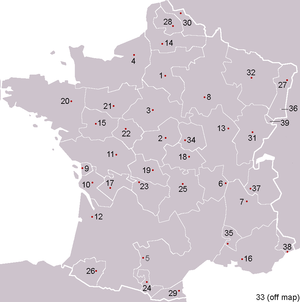Provinces of France: Difference between revisions
cat |
m redirect Nord (département) to Flanders (county) as it was the aim of the article |
||
| Line 45: | Line 45: | ||
<li> [[Artois]] ([[Arras]]) |
<li> [[Artois]] ([[Arras]]) |
||
<li> [[Roussillon]] ([[Perpignan]]) |
<li> [[Roussillon]] ([[Perpignan]]) |
||
<li> [[ |
<li> [[Flanders (county)|Flanders]] and [[Count of Hainaut|Hainaut]] ([[Lille]]) |
||
<li> [[Franche-Comté]] ([[Besançon]]) |
<li> [[Franche-Comté]] ([[Besançon]]) |
||
<li> [[Lorraine (province)|Lorraine]] ([[Nancy]]) |
<li> [[Lorraine (province)|Lorraine]] ([[Nancy]]) |
||
| Line 110: | Line 110: | ||
**[[Valentinois]] |
**[[Valentinois]] |
||
**[[Viennois]] |
**[[Viennois]] |
||
*[[Flanders]] |
*[[Flanders (county)|Flanders]] |
||
**[[Flandre maritime]] |
**[[Flandre maritime]] |
||
**[[Flandre wallonne]] |
**[[Flandre wallonne]] |
||
Revision as of 13:50, 8 July 2006
The Kingdom of France was organized into provinces until March 4, 1790, when the establishment of the département system superseded provinces. The change was an attempt to eradicate local loyalties based on feudal ownership of land and focus all loyalty on the central government in Paris.
The names of the former provinces are still used by geographers to designate natural regions, and several French administrative regions carry their names.
The meaning of "province"
French départements, their names, and their borders were chosen by the central government. In contrast, the existence of provinces came from the droit coutumier ("customary law") and was merely certified by the state. A province, also called a pays ("country"), was characterized by the laws that belonged to it. A province itself could encompass several other provinces. For example, Burgundy was a province but Bresse — another province — was nevertheless a part of Burgundy.
There is therefore no official list of provinces. The list of généralités, administrative subdivisions of the kingdom, is often presented when one wants to establish the list of provinces on the eve of the French Revolution. The list below is much larger, encompassing provinces throughout French history.
List of former provinces of France
Provinces
| Pre-Republican provinces of France, with provincial capitals marked. Listed as English name (capital). | ||
|---|---|---|
|
|

|
Parts of France in 1789
- Alsace
- Angoumois
- Anjou
- Artois
- Aunis
- Auvergne
- Basse-Navarre
- Béarn
- Beaujolais
- Berry
- Bourbonnais
- Burgundy
- Bresse
- Brittany
- Champagne
- Corsica
- Dauphiné
- Flanders
- Pays de Foix
- Forez
- Franche-Comté
- Gascony
- Guyenne
- Île-de-France
- Languedoc
- Landau (Imperial Free City occupied in 1680, restored to Bavaria in 1815)
- Limousin
- Lorraine
- Lyonnais
- Maine
- Marche
- Nivernais
- Normandy
- Orléanais
- Perche
- Picardy
- Poitou
- Provence
- Roussillon
- Saintonge
- Touraine
- Trois-Évêchés
Provinces not part of France in 1789
- Avignon and the Comtat Venaissin, belonging to the Pope were incroporated in 1791
- Montbéliard was incorporated in 1793 as part of the Rauracian Republic, to which it belonged briefly.
- Mulhouse, a Imperial Free City allied with Switzerland was incorporated in 1798
- Savoy and Nice were temporarily annexed to France in the period 1792-1815 but were restored to the Kingdom of Sardinia by the Congress of Vienna. Only in 1860 they were annexed again to France.
